3 Senior Driver Tips You’re Gonna Want to Know
Most Older Golfers Are Making the Same 3 Mistakes. Avoid Those Errors With These Foolproof Senior Driver Tips.
If you’re a senior golfer—or an “experienced” golfer, as I like to say—there’s a good chance your driver shots aren’t as good as they could be.
After 30 years of coaching, I can tell you there are three major mistakes I see older players make time and again. And those errors all stem from two big misunderstandings:
One, they don’t realize that you can’t treat a driver the same way you treat your iron.
Two, they’re still trying to use the techniques they used in their twenties and thirties instead of adapting their swing to capitalize on their strengths as “experienced” golfers.
I don’t want this fate for you. I want you blasting it off the tee long into your retirement years.
So I’m going to explain the three big mistakes you need to avoid and give you three easy tips to make sure you never make those errors again.
Let’s get to it.
Senior Driver Tips: Key Points
Here’s the short version of everything we’re about to cover:
- Your driver shots are the only shots where you’re trying to hit up on a teed-up ball. That means you need to approach your setup and swing differently.
- For driver shots, position the ball farther forward in your stance, bump your lead hip forward, and raise the club handle.
- Instead of swinging low and around, move your lead arm straight up and back on the backswing.
- Finish with the driver handle high.
- If you tend to slice the ball, allow the toe to rotate over a little as you raise the handle at the finish.
- To ensure proper weight shift, make sure you finish with your knees touching.
What Are the Biggest Driver Mistakes Senior Golfers Make?
Before we launch into my three senior driver tips, let me clarify the three big mistakes you’re likely making. When you understand these issues a little better, the tips will make more sense, too.
First, many “experienced” golfers set up their driver shots like they’re hitting an iron.
This will only ever hurt you. In an iron shot, your goal is to hit down on the golf ball—to make contact when the clubhead is still traveling at a downward angle.
With a driver, you’ve got the opposite goal. You want to hit the ball after the clubhead has reached the low point of the swing and is traveling at an upward angle. That’s why you tee it up in the first place.
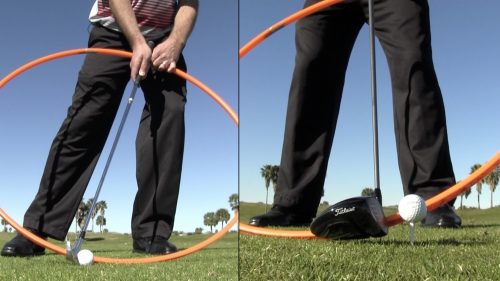
If you’re great at iron shots but making miserable contact on tee shots, this is probably your problem. You’ve got a setup that’s engineered to help you hit down on the ball, not up.
Second, a lot of senior golfers are using a backswing that’s poorly suited to driver shots, especially when the golfer in question isn’t as flexible as they used to be.
I’m going to teach you the fix for that in a bit, and if you follow it, you’re going to pick up a lot more clubhead speed very quickly.
Finally, “experienced” golfers have a habit of falling back when they swing the club. That is to say, they end up with most of their weight on their trail foot. This costs them clubhead speed and moves the low point of their swing farther back in their stance, effectively destroying their contact.
So now that you’re aware of these errors, let’s talk about how you can avoid them.
My 3 Best Senior Driver Tips
Tip #1: Fix Your Setup
As I said before, you’re trying to hit up on the ball when you’re on the tee. You need to master your driver setup to make that happen.
Here’s how:
Driver Ball Position
A lot of golfers set up their driver shots with the ball in the center of their stance. This works great with an iron. It’s terrible for drivers, though.
We want to get the ball farther forward in your stance so you make contact after the low point of your golf swing. I have my students find the perfect spot by doing this:
- Stand with your feet together and the golf ball aligned with the center of your stance.
- Take a small step toward the target with your lead foot.
- Take a much larger step away from the target with your trail foot.
You should end up with the ball just off the inside of your lead arm.
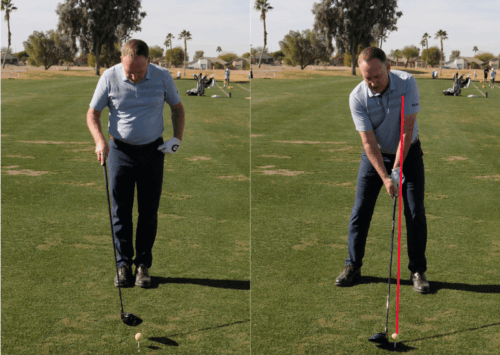
Create Some Tilt
Once you’ve got the ball in the right place, bump your lead hip over your lead foot slightly. That will cause your upper body to tilt back a bit, and that’s going to help you get underneath the golf ball at impact.
This move also encourages you to shift a little more weight into your lead foot—another key component of a solid driver shot.
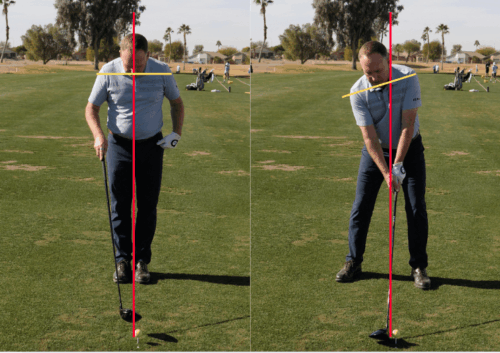
Raise the Handle
I’d be willing to bet you’ve got the handle of your driver too low. Most of my students do when I start working with them.
Raise it just a bit.

Tip #2: Switch to a Vertical Backswing
Now that you’ve fixed your setup, we need to talk backswing.
No matter what you’ve learned, your backswing should not be low and around. It opens up more risks for poor contact and, if I’m honest, it only sets senior golfers up for failure.
The older we get, the harder it is for us to twist deeply, and that’s the only way to get any length on a flat backswing.
The better option is to feel your lead arm working back and up. That vertical swing path allows you to get a lot more length without wringing yourself out.
Try it the next time you’re at the driving range. You’re going to hit it a lot farther.
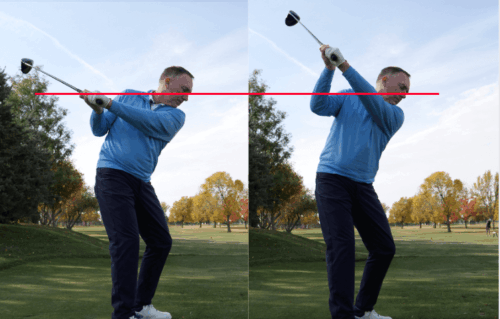
Tip #3: Go for the High-Handle Finish
Never underestimate the importance of your finish. If you make your swing with the intention of ending in the correct position, you’re going to find the proper motion and rhythm naturally.
For a driver shot, you want to finish with your driver handle high. Swinging the club with that goal in mind will help you hit up on the golf ball.
Now, if you tend to slice it, I also encourage you to rotate the toe over a little as you bring the handle up. That might sound strange, but give it a try. I’ve had a lot of students cure their slice quickly this way.

Bonus Driver Tip for Instant Results
Now, before I send you off to put all these ideas to work, let me give you one surprisingly effective tip you can take to the golf course today.
This is a simple feel that’s going to make a world of difference.
When you hit your driver, finish with your knees touching.
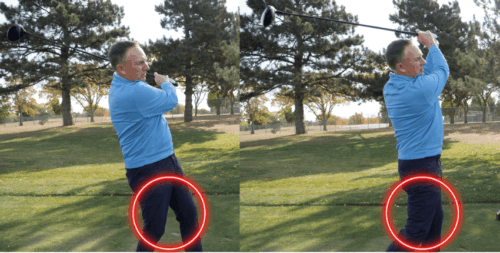
Remember when I said that falling back in the swing is a common senior driver mistake? A lot of golfers stay on their trail foot instead of transferring their weight back to the lead foot as they swing through.
This is the fix. Just focus on getting your knees to touch at the finish. You have to bring that weight forward again in order to pull that off.
And by correcting that weight shift, you’ll get better contact and more power.
What is the Best Driver for Senior Golfers?
Now, I think it’s only fair for you to know that some of the biggest obstacles you face as a senior golfer have nothing to do with you.
A huge one is the fact that all the big-name drivers are designed for younger, professional players. It’s just the nature of the business. Pro golfer endorsements move clubs.
The problem is that these drivers are all designed for the high swing speeds and precision maneuvers of someone who’s young, flexible, and practices for hours a day with world-class coaches.
The brilliant design features that work for them are a big part of the reason you slice it or struggle with shrinking distance.
If you’re serious about improving your tee shots, I recommend checking out the VLS Maxvert 2 driver.
I worked with an award-winning club designer to develop this club specifically for “experienced” golfers. And I gotta be honest: even I have been blown away by the results.
We’ve got golfers over 70 adding 40 yards to their drives with this club. And that’s happening within the first few swings with the Maxvert.
If you want to try it for yourself, get the Maxvert risk-free with a 60-day money-back guarantee here.
Senior Driver Tips: A Recap
Let’s boil this down to one simple checklist. The next time you’re on the tee, remember to:
- Position your ball off the inside of your lead arm.
- Bump your lead hip over your lead foot so your upper body tilts back slightly.
- Raise the club handle.
- Bring your lead arm straight up and back on the backswing.
- Finish with the handle high and your knees together.
Go ahead and give it a try. Then come back to let me know:
What Do You Think?
Do these tips make sense to you? Anything here you didn’t know about before? Do you have any questions to ask or a difference of opinion to share?
I read every comment I get, so please don’t hesitate to sound off below. My team and I love hearing from you.
If you’re ready to take your game to the next level with customized coaching or one-on-one instruction, visit us at VLSCoaching.com. Or drop us an email at Info@VLSGolf.com and put COACHING in the subject line. We’ll get back to you right away.
About the Author
I’m PGA Teaching Professional Todd Kolb—a four-time Golf Digest Best-in-State Instructor, Amazon Best-selling Author, and Minnesota PGA Teacher of the Year. I’ve worked with students of all ages and skill levels in my 30 years of coaching, from first-timers to an LPGA major champion. I’m also the Director of Instruction for VLS Golf and USGolfTV.
My work with VLS Golf and USGolfTV revolves around helping the everyday golfer cut through overcomplicated traditional instruction to find solutions that actually work for them.
 |
|
